As colder weather and shorter days push people indoors for exercise, dermatologists are urging fitness enthusiasts to remain vigilant about potential skin dangers that can arise from regular gym use. While exercise offers countless physical and psychological benefits, experts warn that it can lead to uncomfortable and sometimes severe skin conditions if proper precautions are not taken.
Speaking at the American Academy of Dermatology’s (AAD) SKIN Academy on November 8, Dr. Brian B. Adams, a dermatologist and professor at the University of Cincinnati, highlighted the most common skin problems associated with indoor exercise and guided how to prevent and treat them.
Blisters: A Common but Avoidable Nuisance and Skin Dangers

Blisters are among gym-goers’ most prevalent skin issues, particularly among runners and weightlifters. These fluid-filled pockets form when friction causes the skin’s top layer to separate and fill with fluid. Dr. Adams explains that reducing friction is key to prevention.
“Wearing moisture-wicking socks, applying a thin layer of petroleum jelly, and using gloves during weightlifting can minimize the risk of blisters,” he said. He also emphasized that the skin covering the blister acts as a natural dressing and should not be peeled off. If the blister does open, it must be covered with petroleum jelly and a bandage to prevent infection.
Fungal Infections and Other Skin Dangers Lurk in Locker Rooms
Health clubs are breeding grounds for fungal infections like tinea pedis, commonly known as athlete’s foot. This infection thrives in warm, damp environments such as showers, locker rooms, and inside sweaty shoes. Symptoms include itching, peeling, and redness, often between the toes or on the soles of the feet.
“The best way to prevent athlete’s foot is to always wear shoes, socks, or sandals in communal areas,” advised Dr. Adams. While over-the-counter antifungal treatments are effective in most cases, persistent infections may require prescription-strength medication.
Acne and Abrasions: Unexpected Gym Risks
Regular exercise can also trigger acne mechanica, a type of acne caused by tight-fitting, non-breathable clothing or friction from equipment. To prevent breakouts, Dr. Adams recommends wearing moisture-wicking, breathable fabrics and changing out of sweaty clothes immediately after a workout.
Another common issue is turf burn, an abrasion from contact with exercise mats, basketball courts, or other rough surfaces. Cleaning these abrasions and covering them with petroleum jelly and a bandage is critical for quick healing and to avoid infection.
The Dangers of Indoor Tanning
The most concerning health threat found in some gyms is indoor tanning. Despite the well-documented link between ultraviolet (UV) exposure and skin cancer, many health clubs offer tanning beds. Dr. Adams emphasized that there is “absolutely nothing healthy” about indoor tanning.
“Indoor tanning increases the risk of skin cancer significantly,” Dr. Adams said. He praised the Tanning Accountability and Notification Act, signed into law in 2007, which mandates improved warning labels on tanning devices to educate consumers about these risks.
Keeping Skin Healthy Year-Round
Dr. Adams concluded by stressing the importance of awareness of skin problems that can arise from indoor and outdoor exercise. For outdoor athletes, he recommended broad-spectrum sunscreen with an SPF of 15 or higher, protective clothing, and frequent reapplication of sunscreen during activities like running or skiing.
“Protecting your skin is just as important as protecting your overall health,” Dr. Adams said. “If you experience persistent skin issues, consult a dermatologist to ensure you can exercise safely and comfortably.”
By taking these preventive steps, fitness enthusiasts can focus on staying healthy while avoiding the discomfort and setbacks caused by skin problems.
Reference: American Academy of Dermatology. “Dermatologists Warn Fitness Enthusiasts: Watch For Exercise-Related Skin Problems.” ScienceDaily. ScienceDaily, 16 November 2007.